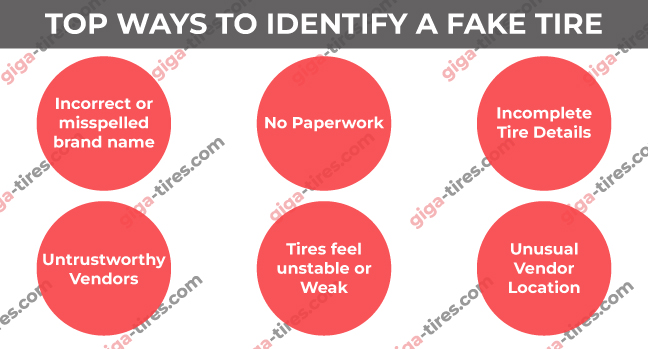Last Updated on 4 months
Guide to Tire Authenticity: Exposing the World of Knock-Off Tires
With its vast and intricate network of components and suppliers, the automotive industry has long been a cornerstone of global commerce and technological advancement. Within this sprawling ecosystem, tires represent a critical and often underappreciated component. Their role in ensuring vehicular safety, performance, and efficiency cannot be overstated. This guide delves deep into the world of tires, shedding light on the lesser-known but increasingly prevalent issue of counterfeit tires.

Background and Scope of the Tire Industry
The tire industry is a dynamic and vital segment of the global economy, contributing significantly to the manufacturing and automotive sectors. It encompasses a wide range of activities, from the research and development of new materials and designs to the mass production and distribution of tires for various vehicle types. This industry is marked by its constant evolution, driven by technological advancements, changes in consumer preferences, and stringent safety regulations.
Major players in the tire industry include well-known brands that have become synonymous with quality and reliability. These companies invest heavily in research and development to create tires with better performance, increased fuel efficiency, and enhanced safety features. The industry is not just limited to producing new tires; it also includes retreading and recycling used tires, emphasizing sustainability and environmental responsibility.
The Critical Role of Authentic Tires
The importance of authentic, high-quality tires cannot be overstated. Tires are the only point of contact between a vehicle and the road, so they are crucial in ensuring the vehicle’s safety, handling, and overall performance. Authentic tires are designed to meet specific standards and undergo rigorous testing to withstand various driving conditions and stresses.
The risks associated with counterfeit or substandard tires are severe. These tires may look similar to genuine products but often need more quality, durability, and safety features than authentic tires. They can be made from inferior materials, have flawed designs, and may have undergone different stringent testing processes. Using such tires can lead to decreased vehicle performance, higher risk of tire failure, and increased likelihood of accidents.
Understanding the tire industry’s scope and the importance of using authentic tires is essential for consumers, manufacturers, and regulatory bodies. The following sections will explore the phenomenon of tire counterfeiting, criteria for identifying genuine tires, and practical strategies for combating this growing concern in the tire industry. Stay tuned as we unfold the layers of this complex issue and provide insights and guidance for navigating the world of tire authenticity.
The Phenomenon of Tire Counterfeiting
In the vast and intricate world of automotive components, tire counterfeiting has emerged as a significant challenge, posing risks to consumers and the integrity of the tire industry. This section delves into the complexities of tire counterfeiting, exploring its definition, scope, and inherent dangers of using counterfeit tires.
Defining Knock-Off Tires
Knock-off tires, commonly called counterfeit tires, imitate authentic tires produced by reputable manufacturers. These imitations are often manufactured without adhering to the strict safety and performance standards that genuine tires undergo. Counterfeit tires can be strikingly similar in appearance to their natural counterparts, making them difficult to identify at a glance. However, they are typically made using inferior materials and processes, significantly compromising quality and safety.
The production of knock-off tires often involves copying tread patterns, sidewall designs, and even branding elements of well-known tire brands. Despite these visual similarities, counterfeit tires lack genuine tires’ essential structural integrity and performance capabilities. They are produced in unauthorized facilities, where the focus is on cutting costs rather than ensuring safety and quality.
The Scope and Scale of Counterfeit Tires in the Market
The problem of tire counterfeiting is not limited to a specific region or country; it is a global issue. The demand for cheaper alternatives to premium brand tires fuels the proliferation of counterfeit tires in the market. This demand often leads unsuspecting consumers to purchase these knock-offs, thinking they are getting a bargain on a quality product.
The scale of this problem is substantial, with countless counterfeit tires infiltrating the market each year. These tires find their way into various channels, including unauthorized dealers, online marketplaces, and retail outlets. The ease of distribution and the difficulty in tracing the origins of these tires make it challenging for authorities and manufacturers to clamp down on this illicit trade.
Potential Hazards of Using Non-Authentic Tires
The use of non-authentic tires poses significant risks. Firstly, these tires often cannot meet the demands of regular driving conditions. They may need better road grip, adequate water dispersion capabilities, and substandard wear resistance. This results in compromised handling and braking, especially in adverse weather conditions, increasing the risk of accidents.
Moreover, counterfeit tires are more likely to suffer from defects like tread separation, blowouts, and rapid wear. Such failures can have catastrophic consequences, particularly at high speeds. The lack of reliability and predictability in performance makes these tires a hazard not only to the drivers who use them but also to others on the road.
Tire counterfeiting is a multifaceted issue with far-reaching implications. Understanding the nature of knock-off tires, the extent of their presence in the market, and the dangers they pose is crucial for consumers, industry players, and regulatory bodies. This awareness is the first step towards combating the spread of counterfeit tires and ensuring the safety and reliability of the tires on our vehicles.
Criteria for Authentic Tires
In the tire industry’s complex landscape, distinguishing authentic tires from counterfeit ones is paramount for safety and performance. This segment of our comprehensive guide focuses on the criteria that set original tires apart, providing insights into the characteristics, certifications, and industry standards that define genuine tires.
Characteristics of Genuine Tires
Authentic tires are distinguished by several key characteristics that ensure their reliability, durability, and safety. These characteristics include:
- Quality of Materials: Genuine tires are manufactured using high-quality materials rigorously tested for strength, flexibility, and durability. These materials are designed to withstand various driving conditions, from extreme temperatures to rough terrain.
- Advanced Design: Authentic tires feature sophisticated tread designs and sidewall construction from extensive research and development. These designs are tailored for optimal traction, handling, and fuel efficiency.
- Consistency in Production: Reputable manufacturers maintain strict quality control throughout production. This consistency ensures that each tire meets high-performance and safety standards.
- Warranty and Support: Genuine tires are backed by manufacturer warranties and support services. These warranties assure quality and offer remedies for defects or premature wear.
Understanding Tire Certification and Branding
Certification and branding are crucial in identifying authentic tires. These elements include:
- Certification Marks: Look for certification marks on the tire, such as the DOT (Department of Transportation) code in the United States. This code indicates that the tire complies with local safety standards.
- Brand-Specific Markings: Authentic tires carry specific branding elements, including logos and unique design features, that are difficult for counterfeiters to replicate accurately.
- Traceability Codes: Genuine tires often have traceability codes that allow the manufacturer to track the tire’s production history. These codes are an integral part of quality assurance.
Industry Standards for Authentic Tires
Industry standards play a crucial role in defining the quality and safety of authentic tires. These standards include:
- Safety Standards: Genuine tires must adhere to national and international safety standards. These standards cover tire strength, tread depth, and resistance to hazards.
- Performance Testing: Authentic tires undergo rigorous performance testing, including tests for grip, handling, and wear resistance under various conditions.
- Environmental Compliance: Reputable tire manufacturers ensure their products comply with environmental regulations, including using eco-friendly materials and processes.
Detecting Counterfeit Tires
The ability to detect counterfeit tires is crucial in automotive safety. Counterfeit tires can compromise vehicle performance and, more critically, endanger lives. This section of our comprehensive guide, featured on the Giga Tires website, focuses on the methods and insights needed to identify fake tires effectively.
The detection of counterfeit tires primarily involves close inspection and a keen eye for detail. Here are some essential inspection techniques:
- Examine the Tread Pattern: Authentic tires have a precise and consistent tread pattern. Counterfeits often have irregular or poorly defined tread patterns due to inferior manufacturing processes.
- Check the Sidewall Information: Legitimate tires display detailed information on their sidewalls, including the brand name, tire size, and safety compliance markings. In counterfeit tires, this information might need to be completed, inaccurately replicated, or even misspelled.
- Look for DOT Codes: The Department of Transportation (DOT) code is a crucial marker of authenticity. This code indicates that the tire meets all the required safety standards. Counterfeit tires often lack a legitimate DOT code or use a falsified one.
- Quality of the Rubber: Genuine tires are made from high-grade rubber that feels robust and durable. Counterfeit tires may use lower-quality rubber that feels excessively hard or brittle.
Common Branding Anomalies in Fake Tires
Counterfeit tires often have noticeable branding anomalies. These anomalies include:
- Incorrect Logos: Counterfeiters may attempt to replicate famous brand logos, but these often have slight differences in design, color, or placement.
- Faulty Branding Elements: Authentic tires have branding elements like watermarks or holograms that are difficult to replicate. Counterfeits usually need more sophisticated branding elements or have poorly executed imitations.
- Inconsistent Branding Across Multiple Tires: In a set of counterfeit tires, there may be inconsistencies in the branding elements from one tire to another. Genuine tires from a reputable brand will have uniform branding.
Material and Construction Variances in Non-Authentic Tires
Material and construction variances are tell-tale signs of counterfeit tires. These variances include:
- Inferior Rubber Compound: The rubber compound in counterfeit tires may show signs of poor quality, such as uneven texture or discoloration.
- Flawed Construction: Genuine tires have a precise and uniform construction. Counterfeit tires may exhibit inconsistencies, such as uneven tread wear, misalignment of structural components, or visible flaws in the tire casing.
- Lack of Reinforcement Materials: Authentic tires are reinforced with steel belts or nylon overlays for durability and stability. Counterfeit tires often lack these critical components or use substandard substitutes.
Consequences of Using Counterfeit Tires
The use of counterfeit tires is a significant concern in the automotive industry, not just for the immediate risks they pose to drivers but also for their broader implications. As part of the comprehensive guide on the Giga Tires, this detailed analysis examines the consequences of using counterfeit tires, encompassing safety concerns, financial implications, and legal ramifications.
Safety Concerns and Accident Data
The primary and most alarming consequence of using counterfeit tires is compromised safety. These substandard tires often fail due to poor construction and inferior materials. Key safety concerns include:
- Increased Risk of Tire Failure: Counterfeit tires are more likely to suffer from blowouts, tread separations, and sidewall ruptures. Such failures can lead to loss of vehicle control, especially at high speeds or in challenging driving conditions.
- Reduced Performance: These tires often perform poorly in critical areas such as braking, handling, and traction, particularly in adverse weather conditions. This can increase the likelihood of accidents.
- Accident Statistics: Although comprehensive data linking accidents directly to counterfeit tires is challenging to compile, numerous reports and studies suggest a correlation between the use of substandard tires and increased accident rates.
Financial Implications for Consumers and Producers
The financial impact of counterfeit tires extends beyond the initial cost savings:
- For Consumers: While counterfeit tires may be cheaper upfront, their poor durability often leads to more frequent replacements. Additionally, tire failures can result in costly vehicle damage and, in severe cases, personal injury claims.
- For Producers: Legitimate tire manufacturers suffer from lost revenue due to counterfeit products. They also need help maintaining brand reputation when consumers mistakenly associate the failures of counterfeit tires with their genuine products.
Legal Consequences of Counterfeit Tire Distribution
The distribution and sale of counterfeit tires carry significant legal implications:
- For Distributors and Retailers: Selling counterfeit tires is illegal and can result in severe penalties, including fines and imprisonment. Businesses guilty of these practices also risk losing their licenses and facing civil lawsuits.
- For Consumers: While consumers are typically victims in these scenarios, there are legal risks associated with knowingly purchasing or using counterfeit tires, particularly if such use results in an accident.
- Regulatory Actions: Governments and regulatory bodies worldwide are intensifying efforts to combat the distribution of counterfeit tires through stricter enforcement, increased penalties, and more rigorous customs inspections.
Safe Tire Acquisition Practices
In the complex world of tire retail, ensuring the authenticity of your purchase is vital. This section of the comprehensive guide on the Giga Tires website focuses on safe tire acquisition practices, offering valuable advice on selecting trustworthy retailers, verifying tire authenticity at the point of sale, and safely purchasing tires online.
Selecting Trustworthy Tire Retailers
Choosing a reputable tire retailer is the first step in ensuring that you are purchasing authentic tires. Here are some tips:
- Look for Established Retailers: Opt for retailers with a solid reputation and a proven track record. Established businesses are more likely to offer authentic, high-quality tires.
- Check for Certifications: Reliable retailers often have certifications from tire manufacturers or industry organizations, indicating that they meet specific tire sales and service standards.
- Seek Recommendations: Personal recommendations from friends, family, or trustworthy automotive professionals can be invaluable.
- Research Online Reviews: Online customer reviews can provide insights into the retailer’s reliability and the quality of its products and services.
Steps for Verifying Tire Authenticity at Point of Sale
Even when buying from a reputable retailer, it is essential to verify the authenticity of the tires. Here is how:
- Inspect the Tire Sidewall: Check for clear, correctly spelled brand names, logos, and other sidewall information, such as tire size and DOT code.
- Look for Quality Markings: Ensure that the tire has all the necessary quality markings, including certifications like the DOT code in the US, which indicates compliance with safety standards.
- Ask for Provenance: Do not hesitate to ask the retailer about the tires’ origin. Genuine retailers should be able to provide information about their supply chain.
Guidelines for Safely Purchasing Tires Online
Online tire shopping offers convenience but requires extra caution. Follow these guidelines:
- Purchase from Recognized Online Retailers: Opt for online retailers with a strong reputation and positive customer reviews.
- Verify Site Authenticity: Ensure the website is legitimate and secure, especially when entering personal and payment information.
- Check Return Policies and Warranties: Familiarize yourself with the online retailer’s return policy and the warranties offered on the tires.
- Beware of Unrealistic Discounts: Be cautious of deals that seem too good to be true, as they may indicate counterfeit products.
- Look for Direct Manufacturer Links: Some tire manufacturers have authorized online dealers. Purchasing through these channels can provide additional assurance of authenticity.
Responses from Industry and Regulators
Counterfeit tires pose significant challenges to consumers, the tire industry, and regulatory bodies. Addressing this problem requires concerted efforts from various stakeholders. This section of our comprehensive guide on the Giga Tires website explores tire manufacturers’ initiatives, legal and regulatory approaches, and the importance of public awareness and education in combating tire counterfeiting.
Initiatives by Tire Manufacturers to Combat Counterfeits
Tire manufacturers play a crucial role in the fight against counterfeit tires. Their initiatives include:
- Enhanced Security Features: Many manufacturers now embed advanced security features in their tires, such as RFID chips, unique serial numbers, or holograms, to help authenticate their products.
- Supply Chain Management: Another strategy involves tightening control over the supply chain. This includes careful selection of suppliers, distributors, and retailers to ensure that counterfeit products do not infiltrate the market.
- Legal Action: Tire manufacturers actively pursue legal action against counterfeiters. This includes lawsuits and working with law enforcement agencies to raid and shut down counterfeit manufacturing operations.
- Collaboration with Other Manufacturers: There is an increasing trend of tire manufacturers cooperating to share information and strategies to combat counterfeiting.
Legal and Regulatory Approaches to Tire Counterfeiting
Legal and regulatory bodies have also ramped up their efforts to combat counterfeit tires:
- Stricter Import Controls: Customs and border protection agencies are implementing more stringent controls to intercept counterfeit tires before they enter the market.
- Enforcement of Intellectual Property Rights: There is increased enforcement of intellectual property laws to protect legitimate tire manufacturers’ patents, trademarks, and designs.
- Penalties and Prosecution: Governments impose harsher penalties and more rigorous prosecution for those producing and distributing counterfeit tires.
- Global Collaboration: There is a growing trend of international collaboration among regulatory bodies to tackle the issue of tire counterfeiting, which often crosses national borders.
Raising Public Awareness and Educational Campaigns
Educating the public is a critical component of the fight against counterfeit tires:
- Consumer Awareness Programs: Manufacturers and industry bodies are launching campaigns to educate consumers on identifying authentic tires and the dangers of counterfeit ones.
- Collaboration with Media and Online Platforms: Using media and online platforms to disseminate information on tire authenticity and the risks associated with counterfeit tires.
- Educational Materials for Retailers and Distributors: Providing training and educational materials to retailers and distributors to help them identify and avoid counterfeit tires.
- School and Community Outreach: Some organizations are extending their educational efforts to schools and community groups to build awareness from a young age.
The response to tire counterfeiting is multifaceted, involving tire manufacturers, legal and regulatory bodies, and public awareness campaigns. These collaborative efforts are essential in safeguarding consumers, protecting the integrity of the tire industry, and ultimately ensuring road safety. As these efforts evolve, staying informed and vigilant remains critical for all stakeholders involved.

Case Studies: The Battle Against Fake Tires
Counterfeit tires are not just a theoretical concern but a real-world problem with numerous documented cases and developed strategies to combat it. This section of the comprehensive guide on the Giga Tires website explores significant incidents of tire counterfeiting and the practical strategies employed to tackle tire fraud.
Significant Incidents of Tire Counterfeiting
Over the years, there have been several high-profile cases of tire counterfeiting, each highlighting different aspects of this illicit trade:
- Major Raids on Counterfeit Factories: There have been instances where law enforcement agencies, in collaboration with tire manufacturers, have conducted raids on factories producing counterfeit tires. These operations often reveal large quantities of fake tires ready for distribution and equipment used to replicate brand markings and other identifiers.
- Seizure of Counterfeit Tires at Ports: Customs officials at various international ports have intercepted significant shipments of counterfeit tires. These seizures often involve thousands of tires, which are destroyed to prevent them from entering the consumer market.
- Online Marketplaces: The rise of e-commerce has led to incidents where counterfeit tires are sold through online platforms. These cases often come to light when consumers or manufacturers identify and report the fakes.
Effective Strategies in Tackling Tire Fraud
Combating tire fraud requires a multi-pronged approach involving various stakeholders:
- Advanced Traceability Measures: Manufacturers increasingly use advanced traceability measures, such as RFID chips and unique serial numbers, to track tires from production to sale. This makes it easier to identify and trace counterfeit products.
- Collaboration with Law Enforcement: Tire manufacturers often work closely with local and international law enforcement agencies to identify and shut down counterfeit tire operations. This collaboration can include training for officers on how to identify fake tires.
- Consumer Education: Educating consumers on how to identify authentic tires is crucial. Manufacturers and retailers provide information on tire markings, quality indicators, and the risks associated with counterfeit tires.
- Strengthening Online Monitoring: Manufacturers and retailers are working to improve the monitoring of online marketplaces and websites to identify and quickly remove listings that sell counterfeit tires.
- Legal Action and Advocacy: Legal action against counterfeiters and advocacy for stricter regulations and penalties are also essential strategies in the battle against tire fraud.
Conclusion & Recommendations
As we conclude this comprehensive exploration into the world of tire authenticity, it is essential to reflect on the critical insights gained and look forward to emerging trends and technologies in tire verification and safety. This guide, presented by GigaTires, has delved into various aspects of tire authenticity, from understanding the perils of counterfeit tires to recognizing the concerted efforts of industry and regulators in combating this issue.
Recap of Principal Takeaways
The journey through this guide has illuminated several critical takeaways:
- The Prevalence of Counterfeit Tires: One of the most alarming revelations is the widespread nature of tire counterfeiting and its implications for safety and performance.
- Identification and Safety Measures: It is paramount to learn how to identify authentic tires, understand the safety risks of counterfeit tires, and recognize the importance of purchasing tires from reputable sources.
- The Role of Industry and Regulation: The tire industry’s response, including manufacturers’ initiatives and the legal framework, plays a crucial role in curbing the spread of counterfeit tires.
- Consumer Awareness: Perhaps most importantly, this guide underscores the need for consumer awareness and education in making informed decisions about tire purchases.
Anticipated Developments in Tire Verification and Safety
Looking ahead, several anticipated developments are set to enhance tire verification and safety:
- Advanced Technology in Tire Production: Innovations such as RFID tags and intelligent tire technologies are expected to become more widespread, offering new ways to track and authenticate tires.
- Stringent Regulations and Compliance: We anticipate stricter regulatory measures and compliance requirements globally, further safeguarding the market against counterfeit tires.
- Enhanced Consumer Awareness Programs: As the fight against counterfeit tires continues, we expect to see more comprehensive consumer education programs to inform and protect tire buyers.
Choose GigaTires
The importance of a trusted and reliable tire provider cannot be overstated when navigating the complexities of tire authenticity. This is where GigaTires steps in as your go-to destination for authentic, high-quality tires. With a commitment to quality and customer satisfaction, GigaTires offers a wide range of tires from reputable manufacturers, ensuring you get the best product for your needs.
Whether you are looking for tires that offer superior performance, durability, or safety, GigaTires has you covered. Our easy-to-use website allows you to browse and compare different tire options, ensuring that you make an informed decision. Moreover, with our stringent quality checks and dedication to authenticity, you can rest assured that every tire purchased from GigaTires is genuine and safe.
Ready to experience the peace of mind that comes with purchasing authentic tires? Visit GigaTires today and explore our extensive selection of top-quality tires. Choose safety, performance, and reliability – choose GigaTires for your next tire purchase. Shop Now.
FAQs
Are knock-off tires good?
Knock-off tires are not recommended as they are often made with inferior materials and lack the rigorous safety and performance testing that authentic tires undergo. They can compromise vehicle safety and performance, leading to increased risks on the road.
What’s wrong with cheap tires?
Cheap tires may offer different quality, durability, or safety features than higher-priced alternatives. They might wear out faster, provide less traction, and potentially fail to meet rigorous safety standards, increasing the risk of accidents.
How can you tell if tires are fake?
To identify fake tires, check for consistency in the tread pattern, irregular branding and logos, absence of quality markings like the DOT code, and poor overall quality compared to genuine tires.
Can tires be counterfeit?
Yes, tires can be counterfeit. Counterfeit tires are unauthorized imitations of reputable brands and often lack authentic tires’ safety, quality, and performance standards.
Do people sell fake tires?
Unfortunately, there are instances where fake tires are sold, often by unauthorized dealers or via online marketplaces. These tires are typically cheaper but carry significant safety risks.
How do I find duplicate tires?
To spot duplicate tires, inspect the quality of the rubber, look for accurate and consistent branding, check for standard safety markings like the DOT code, and compare the tire’s features with those of a tire from a reputable source.









